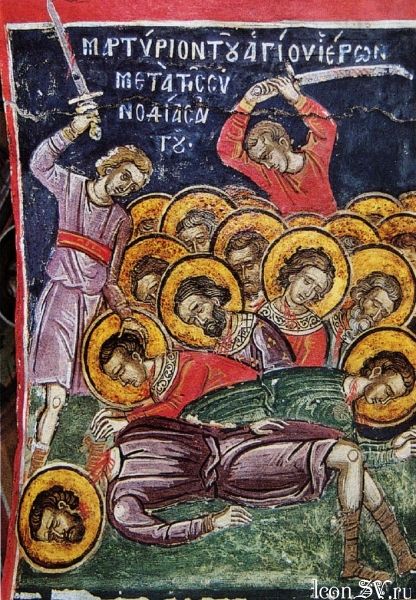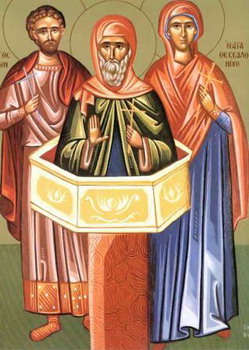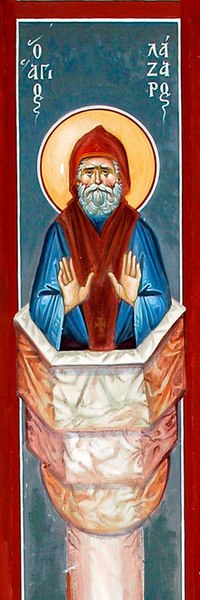|
|
The Holy Martyr Hieron with his Companions He was born in the Cappadocian city of Tijane of a good and God-fearing mother, Stratonica, who was blind. Hieron was a very zealous Christian, and cared for his blind mother with a truly filial love. Because of both his faith and his mother, he refused to go into the army, and fended off and drove away those who were sent to take him, for he was loth to leave his helpless, blind mother and be forced as a soldier to bow down and offer sacrifice to idols. Finally, Hieron was seized and taken before the governor of the city of Melitene, along with other Christians. While they were on the road, a man in white apparel appeared one night to Hieron and said to him: "Behold, Hieron, I reveal to thee thy salvation: thou shalt not wage war for any earthly king, but shalt engage in a battle for the King of heaven, and quickly shalt thou come to Him and receive from Him both honour and glory." Hieron"s heart was filled with ineffable joy at these words. When they reached Melitene, they were all thrown into prison, where Hieron strengthened them all in their faith with great ardour, exhorting them that not one should fall away but that all should freely give their bodies over to torment and death for Christ. To a man, they all confessed their faith in Christ the Lord before the judge, except for one kinsman of Hieron"s called Victor, who repudiated his faith. Hieron"s hands were cut off , then he was flogged and tortured in various ways, until he was finally beheaded with the sword together with the others. Going out to the place of execution, the thirty-three martyrs sang the psalm: "Blessed are those that are undefiled in the way, and walk in the Law of the Lord" (Ps. 1:1). Let us remember by name these honourable martyrs, who are inscribed in the Book of Life: Hesychius, Nicander, Athanasius, Mamas, Barachius, Callinicus, Theogenes, Nikon, Longinus, Theodore, Valerius, Xanticus, Theodulus, Callimachus, Eugene, Theodochus, Ostrichius, Epiphanius, Maximian, Ducitius, Claudian, Theophilus, Gigantius, Dorotheus, Theodotus, Castrichius, Anicetas, Themilius, Eutychius, Hilarion Diodotus and Amonitus. A certain man called Chrysanthus found Hieron"s severed head and gave it burial, and he later built over it a church in honour of St Hieron. One of the martyr"s hands was taken to his blind mother. St Hieron suffered with his companions in 298, and entered into the glory of Christ. He was born in the Cappadocian city of Tijane of a good and God-fearing mother, Stratonica, who was blind. Hieron was a very zealous Christian, and cared for his blind mother with a truly filial love. Because of both his faith and his mother, he refused to go into the army, and fended off and drove away those who were sent to take him, for he was loth to leave his helpless, blind mother and be forced as a soldier to bow down and offer sacrifice to idols. Finally, Hieron was seized and taken before the governor of the city of Melitene, along with other Christians. While they were on the road, a man in white apparel appeared one night to Hieron and said to him: "Behold, Hieron, I reveal to thee thy salvation: thou shalt not wage war for any earthly king, but shalt engage in a battle for the King of heaven, and quickly shalt thou come to Him and receive from Him both honour and glory." Hieron"s heart was filled with ineffable joy at these words. When they reached Melitene, they were all thrown into prison, where Hieron strengthened them all in their faith with great ardour, exhorting them that not one should fall away but that all should freely give their bodies over to torment and death for Christ. To a man, they all confessed their faith in Christ the Lord before the judge, except for one kinsman of Hieron"s called Victor, who repudiated his faith. Hieron"s hands were cut off , then he was flogged and tortured in various ways, until he was finally beheaded with the sword together with the others. Going out to the place of execution, the thirty-three martyrs sang the psalm: "Blessed are those that are undefiled in the way, and walk in the Law of the Lord" (Ps. 1:1). Let us remember by name these honourable martyrs, who are inscribed in the Book of Life: Hesychius, Nicander, Athanasius, Mamas, Barachius, Callinicus, Theogenes, Nikon, Longinus, Theodore, Valerius, Xanticus, Theodulus, Callimachus, Eugene, Theodochus, Ostrichius, Epiphanius, Maximian, Ducitius, Claudian, Theophilus, Gigantius, Dorotheus, Theodotus, Castrichius, Anicetas, Themilius, Eutychius, Hilarion Diodotus and Amonitus. A certain man called Chrysanthus found Hieron"s severed head and gave it burial, and he later built over it a church in honour of St Hieron. One of the martyr"s hands was taken to his blind mother. St Hieron suffered with his companions in 298, and entered into the glory of Christ.The Holy Martyr Thessalonica, with Auctus and Taurion This maiden was the daughter of Cleon, a pagan priest, a rich and arrogant man. Because of her faith in Christ, her father drove her from the house and the city. Two respected citizens, Auctus and Taurion by name, reproached Cleon for his inhuman treatment of his daughter, and Cleon thereupon denounced them as Christians. They were savagely tortured and beheaded for Christ, and the maiden Thessalonica was tortured and killed soon after. They suffered in the Macedonian city of Amphipolis, near present-day Kavala, and so these martyrs were found worthy, by their sufferings, of the immortal Kingdom. This maiden was the daughter of Cleon, a pagan priest, a rich and arrogant man. Because of her faith in Christ, her father drove her from the house and the city. Two respected citizens, Auctus and Taurion by name, reproached Cleon for his inhuman treatment of his daughter, and Cleon thereupon denounced them as Christians. They were savagely tortured and beheaded for Christ, and the maiden Thessalonica was tortured and killed soon after. They suffered in the Macedonian city of Amphipolis, near present-day Kavala, and so these martyrs were found worthy, by their sufferings, of the immortal Kingdom.Our Holy Father Lazarus of Mount Galesius A pillar of light appeared above the house where he was born. He left his village in Magnesia and went to Jerusalem on pilgrimage to the holy places, becoming a monk there in the monastery of St Sava the Sanctified. After ten years, he settled on Mount Galesius and toiled in asceticism upon a pillar as a stylite, and was a wonderworker both during his lifetime and after his death. The Emperor Constantine Monomachus had great respect for him. St Lazarus entered into his eternal home at the end of the eleventh century. A pillar of light appeared above the house where he was born. He left his village in Magnesia and went to Jerusalem on pilgrimage to the holy places, becoming a monk there in the monastery of St Sava the Sanctified. After ten years, he settled on Mount Galesius and toiled in asceticism upon a pillar as a stylite, and was a wonderworker both during his lifetime and after his death. The Emperor Constantine Monomachus had great respect for him. St Lazarus entered into his eternal home at the end of the eleventh century.Martyrs Melasippus, Cassina, their son Antoninus (363)The Holy Martyrs Melasippos and Kasynia and their son Antoninos suffered during the reign of the emperor Julian the Apostate in the city of Ancyra in Phrygia in the year 363. The holy Martyrs Melasippos and Kasynia, lacerated by iron hooks and exhausted, died under torture. Their son the lad Antoninos, whom the persecutor forced to watch the torturing of his parents, spat in the face of the God-apostate emperor. For this he was subjected to cruel tortures, in which he remained unharmed, and then he was beheaded. And forty other youths, witnessing that the Lord had preserved His confessor Antoninos unharmed by tortures, believed in Christ, and they openly confessed their faith and accepted death by martyrdom.
Martyrs Auctus, Taurion, and Thessalonica at Amphipolis in Macedonia Saint Thessalonikia was the daughter of a pagan priest. When the impious father learned that his daughter was become a Christian, he ruthlessly beat her and threw her out of the house, bereft of any means of providing for herself. Saints Auktos and Taurion attempted to intercede for the girl and to reason with the embittered father. The pagan priest denounced them both to the authorities, and they were arrested. Having confessed their faith in Christ afront the torturers and having undergone cruel tortures, the saints were then beheaded. Soon after their martyr's death, Saint Thessalonikia also died. Her body was reverently buried in the city of Amphypolis in Macedonia, together with the holy Martyrs Auktos and Taurion. Saint Thessalonikia was the daughter of a pagan priest. When the impious father learned that his daughter was become a Christian, he ruthlessly beat her and threw her out of the house, bereft of any means of providing for herself. Saints Auktos and Taurion attempted to intercede for the girl and to reason with the embittered father. The pagan priest denounced them both to the authorities, and they were arrested. Having confessed their faith in Christ afront the torturers and having undergone cruel tortures, the saints were then beheaded. Soon after their martyr's death, Saint Thessalonikia also died. Her body was reverently buried in the city of Amphypolis in Macedonia, together with the holy Martyrs Auktos and Taurion.Martyr Alexander of Thessalonica (305)
Martyr Athenodorus
St. Gregory (3rd c.)Brother of St. Gregory the Wonderworker
|